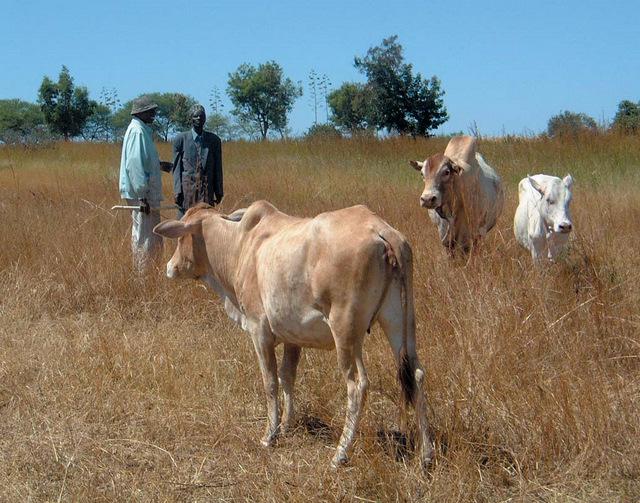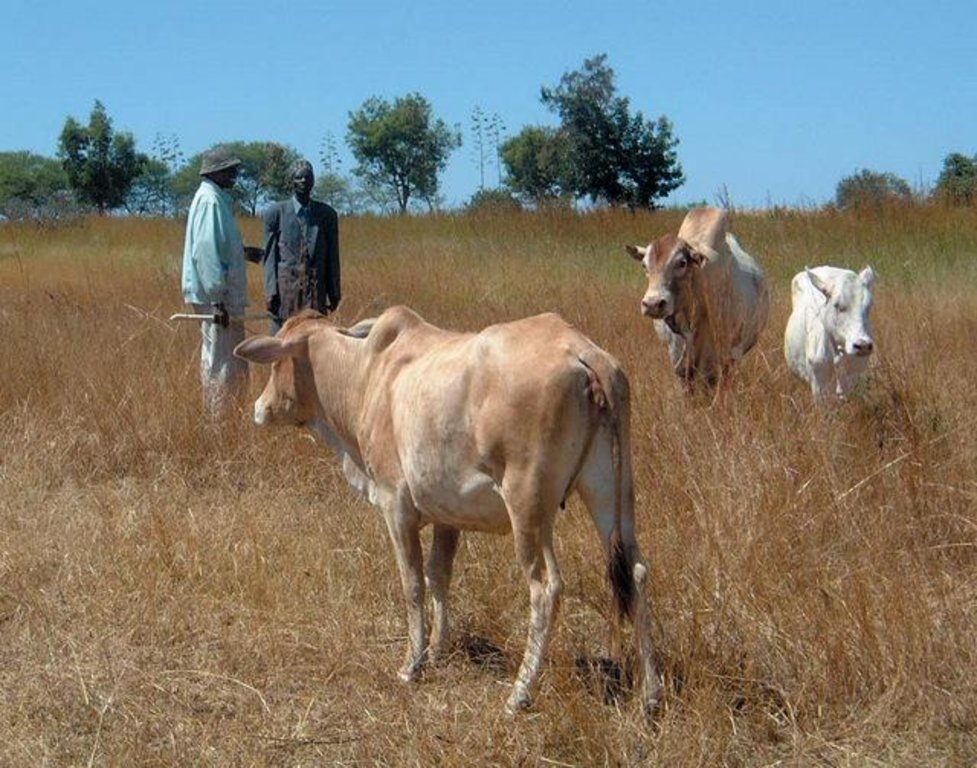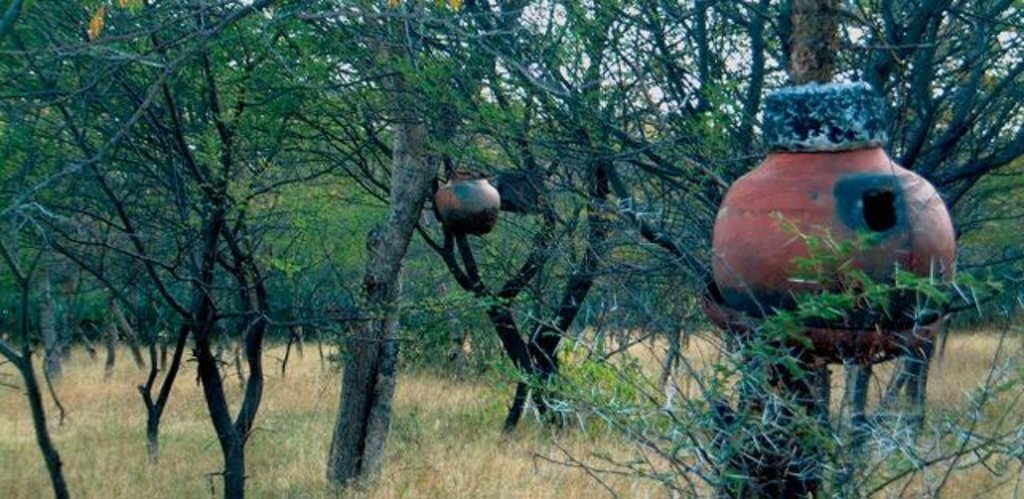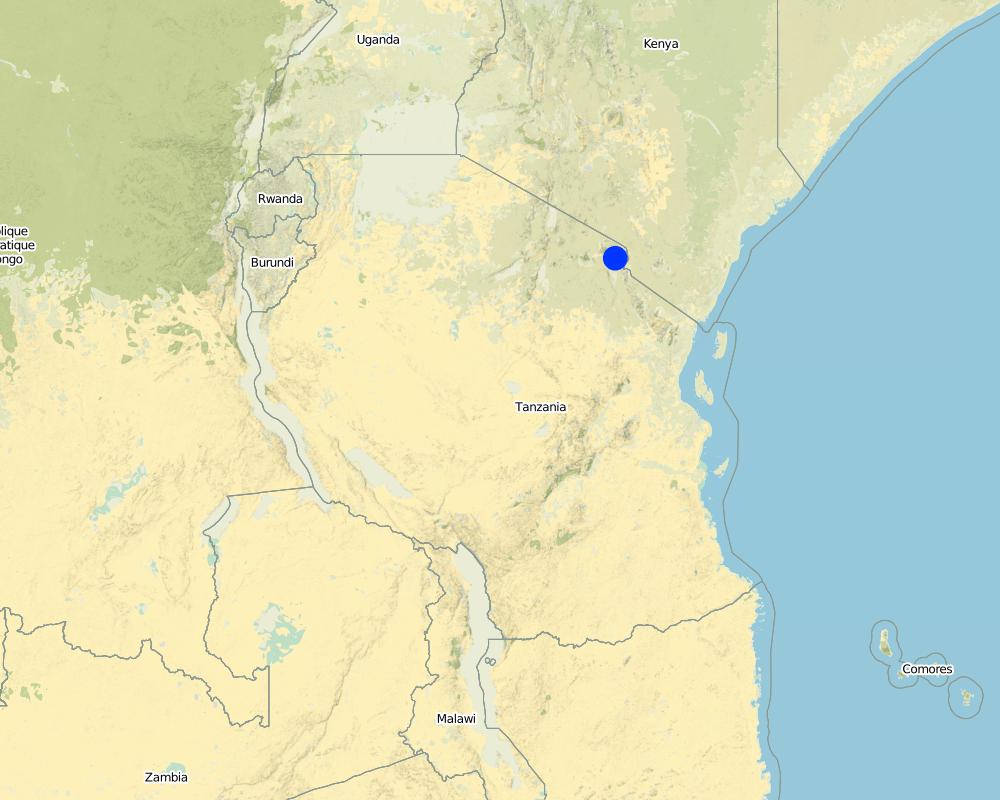Ngitili Dry-Season Fodder Reserves [ប្រទេសតង់សានី]
- ការបង្កើត៖
- បច្ចុប្បន្នភាព
- អ្នកចងក្រង៖ Unknown User
- អ្នកកែសម្រួល៖ –
- អ្នកត្រួតពិនិត្យច្រើនទៀត៖ David Streiff, Deborah Niggli, Alexandra Gavilano
Ngitili
technologies_1351 - ប្រទេសតង់សានី
ពិនិត្យមើលគ្រប់ផ្នែក
ពង្រីកមើលទាំងអស់ បង្រួមទាំងអស់1. ព័ត៌មានទូទៅ
1.2 ព័ត៌មានលម្អិតពីបុគ្គលសំខាន់ៗ និងស្ថាប័នដែលចូលរួមក្នុងការវាយតម្លៃ និងចងក្រងឯកសារនៃបច្ចេកទេស
បុគ្គលសំខាន់ម្នាក់ (ច្រើននាក់)
អ្នកជំនាញឯកទេស SLM:
Barrow Edmund
ឈ្មោះគម្រោងដែលបានចងក្រងឯកសារ/ វាយតម្លៃលើបច្ចេកទេស (បើទាក់ទង)
Book project: SLM in Practice - Guidelines and Best Practices for Sub-Saharan Africa (SLM in Practice)1.3 លក្ខខណ្ឌទាក់ទងទៅនឹងការប្រើប្រាស់ទិន្នន័យដែលបានចងក្រងតាមរយៈ វ៉ូខេត
អ្នកចងក្រង និង(បុគ្គលសំខាន់ៗ)យល់ព្រមទទួលយកនូវលក្ខខណ្ឌនានាទាក់ទងទៅនឹងការប្រើប្រាស់ទិន្នន័យដែលបានចងក្រងតាមរយៈវ៉ូខេត:
បាទ/ចា៎
2. ការពណ៌នាពីបច្ចេកទេស SLM
2.1 ការពណ៌នាដោយសង្ខេបពីបច្ចេកទេស
និយមន័យបច្ចេកទេស:
Ngitili are traditional enclosures for in-situ conservation and rehabilitation of vegetation, practiced by the Wasukuma agropastoralists in Shinyanga, Tanzania.
2.2 ការពណ៌នាលម្អិតពីបច្ចេកទេស
ការពណ៌នា:
Shinyanga is a semiarid area characterized by shortage of fodder associated with problems of deforestation, fuelwood scarcity, food insecurity, declining soil fertility, severe soil erosion and unsecure land use rights. Ngitili is a dry-season fodder reserve, an indigenous practice which has been revived by a government programme from 1986-2001. For initial regeneration of the vegetation and rehabilitation of denuded land absolute exclusion of up to 5 years is needed. Then, areas of standing vegetation are enclosed seasonally from the onset of the rainy season till the peak / end of dry season, before they are opened up for grazing. Two distinct vegetation strata are identifiable, an upper stratum dominated by trees and shrubs (Acacia tortilis, A. nilotica, A. polyacantha and A. seyal) and a lower stratum of grasses, herbs and forbs. Structure and composition of the ngitili areas are closely influenced by location, age, management practices and intensity of use. The reserves are established on degraded land and around homesteads. Individual plots usually reach 2-5 ha in size, while communal ngitili cover 10-200 ha. Mostly, the boundaries are not rigidly marked, and physical barriers are not established. Local guards and community by-laws are used to protect and enforce the system. Ngitili alleviates dry season fodder shortages and prevents land degradation, through reducing soil erosion and deforestation. The reserves provide a wide range of woodland goods - such as timber, fodder, fuelwood, medicinal herbs, wild fruits and honey. They help to enhance livelihoods, provide a vital safety net during dry seasons and droughts and generate additional income of up to US$ 500-1,000 per year and household. Ngitili greatly reduced women’s labour, cutting the time spent on fuelwood collection by over 80%, and have a highly positive impact on biodiversity
2.3 រូបភាពនៃបច្ចេកទេស
2.5 ប្រទេស/តំបន់/ទីតាំងកន្លែង ដែលបច្ចេកទេសត្រូវបានអនុវត្ត និងបានគ្រប់ដណ្តប់ដោយការវាយតម្លៃនេះ
ប្រទេស:
ប្រទេសតង់សានី
តំបន់/រដ្ឋ/ខេត្ត:
Shinyanga region
បញ្ជាក់ពីការសាយភាយនៃបច្ចេកទេស:
- អនុវត្តនៅកន្លែងជាក់លាក់មួយ/ ប្រមូលផ្តុំនៅតំបន់តូចៗ
Map
×2.6 កាលបរិច្ឆេទនៃការអនុវត្ត
ប្រសិនបើមិនច្បាស់ឆ្នាំ សូមបញ្ជាក់កាលបរិច្ឆេទដែលប្រហាក់ប្រហែល:
- ច្រើនជាង 50 ឆ្នាំមុន (ប្រពៃណី)
2.7 ការណែនាំពីបច្ចេកទេស
សូមបញ្ជាក់តើបច្ចេកទេសត្រូវបានណែនាំឱ្យអនុវត្តដោយរបៀបណា:
- ជាផ្នែកនៃប្រព័ន្ធប្រពៃណី (> 50 ឆ្នាំ)
មតិយោបល់ (ប្រភេទនៃគម្រោង ។ល។):
an indigenous practice which has been revived by a government programme from 1986-2001
3. ចំណាត់ថ្នាក់នៃបច្ចេកទេស SLM
3.1 គោលបំណងចម្បង (១ ឬច្រើន) នៃបច្ចេកទេសនេះ
- កាត់បន្ថយ, បង្ការ, ស្តារឡើងវិញនូវការធ្លាក់ចុះគុណភាពដី
3.2 ប្រភេទដីប្រើប្រាស់មួយប្រភេទ (ច្រើនប្រភេទ) ដែលបានអនុវត្តបច្ចេកទេស

ដីដាំដំណាំ
- ប្រភេទដើមឈើធំៗ និងដើមឈើតូចៗ
- Acacia tortilis, A. nilotica, A. polyacantha and A. seya
ចំនួនសារដែលដាំដំណាំក្នុងមួយឆ្នាំ:
- 1

ដីសម្រាប់ចិញ្ចឹមសត្វ
វាលស្មៅធំៗ:
- ពាក់កណ្តាលពនេចរ

ដីព្រៃ/ដីដាំដើមឈើ
ផលិតផល និងសេវាកម្ម:
- ឈើហ៊ុប
- អុស
- ផ្លែឈើ និងគ្រាប់ធញ្ញជាតិ
- ផលិតផលព្រៃផ្សេងៗ
- វាលស្មៅ
មតិយោបល់:
Major land use problems (compiler’s opinion): shortage of fodder associated with problems of deforestation, fuelwood scarcity, food insecurity, declining soil fertility, severe soil erosion and unsecure land use rights
Semi-nomadism / pastoralism: Yes
Future (final) land use (after implementation of SLM Technology): Mixed: Ms: Silvo-pastoralism
3.3 បន្ទាប់ពីអនុវត្តបច្ចេកទេស តើដីប្រើប្រាស់មានការប្រែប្រួលដែររឺទេ?
បន្ទាប់ពីអនុវត្តបច្ចេកទេស តើដីប្រើប្រាស់មានការប្រែប្រួលដែររឺទេ?
- បាទ/ច៎ា (សូមបំពេញសំណួរខាងក្រោមពីស្ថានភាពដីប្រើប្រាស់មុនពេលអនុវត្តបច្ចេកទេស)
ដីប្រើប្រាស់ចម្រុះនៅលើដីតែមួយ:
បាទ/ចា៎
បញ្ជាក់ពីប្រភេទដីច្រើនប្រភេទ (ដីដាំដំណាំ/ដីចិញ្ចឹមសត្វ/ដីព្រៃឈើ):
- ដីព្រៃឈើ និងដីចិញ្ចឹមសត្វ

ដីសម្រាប់ចិញ្ចឹមសត្វ
3.4 ការផ្គត់ផ្គង់ទឹក
ការផ្គត់ផ្គង់ទឹកនៅកន្លែងអនុវត្តបច្ចេកទេស:
- ទឹកភ្លៀង
3.5 ក្រុម SLM ដែលបច្ចេកទេសស្ថិតនៅក្នុង
- តំបន់ទ្រនាប់ (បិទការប្រើប្រាស់ គាំទ្រដល់ការស្តារឡើងវិញ)
- កសិរុក្ខកម្ម (pastoralism) និងការគ្រប់គ្រងដីសម្រាប់ចិញ្ចឹមសត្វ
3.6 វិធានការ SLM ដែលបញ្ចូលនូវបច្ចេកទេស

វិធានការរុក្ខជាតិ
- V1: ឈើធំៗ និងដើមឈើតូចៗ

វិធានការគ្រប់គ្រង
- M4: ការផ្លាស់ប្តូរចម្បងៗក្នុងការកំណត់ ពេលអនុវត្តសកម្មភាព
មតិយោបល់:
Type of vegetative measures: scattered / dispersed
3.7 កំណត់ប្រភេទនៃការធ្លាក់ចុះគុណភាពដីសំខាន់ៗដែលបច្ចេកទេសនេះបានដោះស្រាយ

ការហូរច្រោះដីដោយសារទឹក
- Wt: ការបាត់ដីស្រទាប់លើដោយការហូរច្រោះ

ការបាត់ដីដោយសារខ្យល់
- Et: ការបាត់បង់ដីស្រទាប់លើ

ការធ្លាក់ចុះសារធាតុគីមីក្នុងដី
- Cn: ការថយចុះជីជាតិ និងកាត់បន្ថយបរិមាណសារធាតុសរីរាង្គ (មិនកើតឡើងដោយការហូរច្រោះទេ)

ការធ្លាក់ចុះជីវសាស្ត្រនៃដី
- Bc: ការថយចុះនូវគម្របរុក្ខជាតិ
- Bq: ការថយចុះនូវជីវម៉ាស/ បរិមាណ
- Bs: សមាសភាពដែលមានគុណភាពនិងប្រភេទសត្វ/ការថយចុះនូវជីវចម្រុះ
មតិយោបល់:
Main type of degradation addressed: Wt: loss of topsoil / surface erosion, Et: loss of topsoil, Cn: fertility decline and reduced organic matter content, Bc: reduction of vegetation cover, Bq: quantity / biomass decline, Bs: quality and species composition /diversity decline
3.8 ការពារ កាត់បន្ថយ ឬស្តារឡើងវិញនៃការធ្លាក់ចុះគុណភាពដី
បញ្ជាក់ពីគោលដៅរបស់បច្ចេកទេស ដែលផ្តោតទៅការធ្លាក់ចុះគុណភាពដី:
- ការជួសជុល/ ស្តារឡើងវិញនៃឱនភាពដីធ្ងន់ធ្ងរ
4. បច្ចេកទេសជាក់លាក់ សកម្មភាពអនុវត្ត ធាតុចូល និងថ្លៃដើម
4.1 គំនូសបច្ចេកទេសនៃបច្ចេកទេសនេះ
លក្ខណៈពិសេសនៃបច្ចេកទេស (ទាក់ទងនឺងគំនូរបច្ចេកទេស):
Technical knowledge required for field staff / advisors: low
Technical knowledge required for land users: low
Main technical functions: control of raindrop splash, improvement of ground cover, stabilisation of soil (eg by tree roots against land slides), increase in organic matter, increase in nutrient availability (supply, recycling,…), increase of biomass (quantity), promotion of vegetation species and varieties (quality, eg palatable fodder)
Secondary technical functions: increase of infiltration
Scattered / dispersed
Vegetative material: T : trees / shrubs
Trees/ shrubs species: Acacia tortilis, A. nilotica, A. polyacantha and A. seyal
Major change in timing of activities: For initial regeneration of the vegetation and rehabilitation of denuded land absolute exclusion of up to 5 years is needed. Then, areas of standing vegetation are enclosed seasonally from the onset o
4.3 សកម្មភាពបង្កើត
| សកម្មភាព | រយៈពេល (រដូវកាល) | |
|---|---|---|
| 1. | Demarcation and closure of sites usually on degraded land around homesteads | |
| 2. | Total enclosure during up to 5 years for initial regeneration of vegetation (if land is degraded) | |
| 3. | Temporary demarcation of paddocks for specific periods for rotational grazing within ngitili (controlled by experienced elders; based on utilization level and fodder availability) | |
| 4. | Controlled pruning and thinning (for firewood and poles) |
4.5 សកម្មភាពថែទាំ
| សកម្មភាព | ពេលវេលា/ ភាពញឹកញាប់ | |
|---|---|---|
| 1. | Closure of ngitili area at onset of rainy season. No management during rainy season | |
| 2. | Open area for grazing in July or August, after the crop residues and fallow vegetation have been depleted | |
| 3. | Temporary demarcation of paddocks for specific periods for rotational grazing within ngitili (controlled by experienced elders; based on utilization level and fodder availability) | |
| 4. | Controlled pruning and thinning (for firewood and poles) |
5. លក្ខណៈបរិស្ថានធម្មជាតិ និងមនុស្ស
5.1 អាកាសធាតុ
បរិមាណទឹកភ្លៀងប្រចាំឆ្នាំ
- < 250 មម
- 251-500 មម
- 501-750 មម
- 751-1,000 មម
- 1,001-1,500 មម
- 1,501-2,000 មម
- 2,001-3,000 មម
- 3,001-4,000 មម
- > 4,000 មម
តំបន់កសិអាកាសធាតុ
- មានភ្លៀងតិចតួច
Thermal climate class: tropics
Unimodal rainfall pattern
5.2 សណ្ឋានដី
ជម្រាលជាមធ្យម:
- រាបស្មើ (0-2%)
- ជម្រាលតិចតួច (3-5%)
- មធ្យម (6-10%)
- ជម្រាលខ្ពស់បន្តិច (11-15%)
- ទីទួល (16-30%)
- ទីទួលចោត (31-60%)
- ទីទួលចោតខ្លាំង (>60%)
ទម្រង់ដី:
- ខ្ពង់រាប
- កំពូលភ្នំ
- ជម្រាលភ្នំ
- ជម្រាលទួល
- ជម្រាលជើងភ្នំ
- បាតជ្រលងភ្នំ
តំបន់តាមរយៈកម្ពស់ :
- 0-100 ម
- 101-500 ម
- 501-1,000 ម
- 1,001-1,500 ម
- 1,501-2,000 ម
- 2,001-2,500 ម
- 2,501-3,000 ម
- 3,001-4,000 ម
- > 4,000 ម
5.3 ដី
បើអាចសូមភ្ជាប់ការពណ៌នាពីដីឱ្យបានច្បាស់ ឬព័ត៌មានដែលអាចទទួលបាន ឧ. ប្រភេទដី, pH ដី/ ជាតិអាស៊ីត, សមត្ថភាពផ្លាស់ប្តូរកាចុង, វត្តមាននីត្រូសែន, ភាពប្រៃ ។ល។:
Soil texture (topsoil): Vertic soils are very extensive covering 47% of all soil types in the region
Soil drainage / infiltration is medium - poor
5.6 លក្ខណៈនៃអ្នកប្រើប្រាស់ដីដែលអនុវត្តបច្ចេកទេស
កម្រិតប្រើប្រាស់គ្រឿងយន្ត:
- ប្រើកម្លាំងពលកម្ម
5.8 ភាពជាម្ចាស់ដី កម្មសិទ្ធប្រើប្រាស់ដី និងកម្មសិទ្ធប្រើប្រាស់ទឹក
កម្មសិទ្ធិប្រើប្រាស់ដី:
- ជាក្រុម (មានដែនកំណត់)
- ឯកជន
មតិយោបល់:
individual (cropland), individual/communal 50%/50% (grazing land)
Land ownership: communal / village, individual, not titled, individual, titled
6. ផលប៉ះពាល់ និងការសន្និដ្ឋាន
6.1 ផលប៉ះពាល់ក្នុងបរិវេណអនុវត្តបច្ចេកទេសដែលកើតមាន
ផលប៉ះពាល់លើសេដ្ឋកិច្ចសង្គម
ផលិតផល
ផលិតកម្មចំណីសត្វ
មតិយោបល់/ ការបញ្ជាក់:
dry season
ផលិតកម្មសត្វ
ផលិតកម្មឈើ
មតិយោបល់/ ការបញ្ជាក់:
timber, fuelwood
អនុផលព្រៃឈើ
មតិយោបល់/ ការបញ្ជាក់:
fruit, honey, medicines, edible insects
ចំណូល និងថ្លៃដើម
ចំណូលក្នុងកសិដ្ឋាន
មតិយោបល់/ ការបញ្ជាក់:
from selling timber/fuelwood; to purchase agricultural inputs, manpower
បន្ទុកការងារ
មតិយោបល់/ ការបញ្ជាក់:
collection of fuelwood / fodder by women
ផលប៉ះពាល់ទៅលើវប្បធម៌សង្គម
សន្តិសុខស្បៀង/ ភាពគ្រប់គ្រាន់ខ្លួនឯង
ស្ថានភាពសុខភាព
diet diversification
housing
មតិយោបល់/ ការបញ្ជាក់:
thatched grass for roofs
education
មតិយោបល់/ ការបញ្ជាក់:
school fees payment due to income from ngitili
Income from communal ngitili used for village development
មតិយោបល់/ ការបញ្ជាក់:
schools, health centres
ផលប៉ះពាល់ទៅលើអេកូឡូស៊ី
វដ្តទឹក/លំហូរ
បរិមាណទឹក
មតិយោបល់/ ការបញ្ជាក់:
increased water availability
ដី
គម្របដី
ការបាត់បង់ដី
វដ្តនៃសារធាតុចិញ្ចឹម/ការទទួលបាន
ជីវចម្រុះ៖ ដំណាំ, សត្វ
ភាពសម្បូរបែបនៃសត្វ
មតិយោបល់/ ការបញ្ជាក់:
152 plant species; 145 bird species; also mammals returning
6.3 ភាពប្រឈម និងភាពរួសនៃបច្ចេកទេសទៅនឹងការប្រែប្រួលអាកាសធាតុ និងគ្រោះអាកាសធាតុ/ គ្រោះមហន្តរាយ (ដែលដឹងដោយអ្នកប្រើប្រាស់ដី)
មតិយោបល់:
Increased tolerance to climatic extremes (e.g. prolonged dry spells and droughts)
6.4 ការវិភាគថ្លៃដើម និងអត្ថប្រយោជន៍
តើផលចំណេញ និងថ្លៃដើមត្រូវបានប្រៀបធៀបគ្នាយ៉ាងដូចម្តេច (ទស្សនៈរបស់អ្នកប្រើប្រាស់ដី)?
រយៈពេលខ្លី:
វិជ្ជមានតិចតួច
រយៈពេលវែង:
វិជ្ជមានខ្លាំង
តើផលចំណេញ និងការថែទាំ/ ជួសជុលត្រូវបានប្រៀបធៀបគ្នាយ៉ាងដូចម្តេច (ទស្សនៈរបស់អ្នកប្រើប្រាស់ដី)?
រយៈពេលខ្លី:
វិជ្ជមានតិចតួច
រយៈពេលវែង:
វិជ្ជមានខ្លាំង
6.5 ការទទួលយកបច្ចេកទេស
- > 50%
មតិយោបល់:
Comments on adoption trend: 300’000-500’000 ha of woodland restored 1986-2001 (most of Ngitilis are individual, but area-wise half-half), over 800 villages; 60-70% of all households have Ngitilis
6.7 ភាពខ្លាំង/ គុណសម្បត្តិ/ ឱកាសនៃបច្ចេកទេស
| ភាពខ្លាំង/ គុណសម្បត្តិ/ ឱកាស ទស្សនៈរបស់បុគ្គលសំខាន់ៗ |
|---|
| Generates many production and ecological benefits at the same time |
6.8 ភាពខ្សោយ/ គុណវិបត្តិ/ ហានិភ័យនៃបច្ចេកទេស និងវិធីសាស្ត្រដោះស្រាយ
| ភាពខ្សោយ/ គុណវិបត្តិ/ ហានិភ័យ ទស្សនៈរបស់អ្នកប្រើប្រាស់ដី | តើបច្ចេកទេសទាំងនោះបានដោះស្រាយបញ្ហាដូចម្តេច? |
|---|---|
| Damage to livestock and crops caused by growing wildlife populations | outweighed by the benefits gained from ngitili (in most areas) |
| Increased local inequity: benefit gap between richer and poorer house¬holds (who have no ngitilis); growing sales of ngitilis | local institutions have to enable people to hold on to land and maintain ngitilis; allow poorer households to benefit from communal ngitilis |
| Scarcity of land, growing pressure (rising human and livestock populations); conflicts over grazing rights | encourage villages to establish by-laws for protecting ngitilis |
| Insecurity of tenure impedes establishment of ngitilis (individual and communal) | increase local people’s and groups ownership and control over their resources; clearly acknowledge in national law the secure tenure of both private and communal ngitili |
| Productivity could still be improved | introduction of improved fodder grasses. Planting of fast growing fodder trees and/or shrubs |
7. ឯកសារយោង និងវេបសាយ
7.2 ឯកសារយោងដែលបានចេញផ្សាយ
ចំណងជើង អ្នកនិពន្ធ ឆ្នាំ ISBN:
Kamwenda G.J. 2002. Ngitili agrosilvopastoral systems in the United Republic of Tanzania. Unasylva 211, Vol. 53, 2002.
ចំណងជើង អ្នកនិពន្ធ ឆ្នាំ ISBN:
World Resource Institute. 2010. Regenerating Woodlands: Tanzania's HASHI Project. http://www.wri.org/publication/content/8108
ចំណងជើង អ្នកនិពន្ធ ឆ្នាំ ISBN:
Equator initiative. 2010. Nomination Form Equator Initiative. http://www.equatorinitiative.org/knowledgebase/files/2002-0128_Nom_HASHI_Tanzania.pdf
ចំណងជើង អ្នកនិពន្ធ ឆ្នាំ ISBN:
Blay D., E. Bonkoungou, S.A.O. Chamshama and B.Chikamai. 2004. Rehabilitation of Degraded Lands in Sub-Saharan Africa: Lessons Learned from Selected Case Studies. Forestry research network for Sub-Saharan Africa (fornessa)
ចំណងជើង អ្នកនិពន្ធ ឆ្នាំ ISBN:
WRI (2005): World Resources 2005: The Wealth of the Poor—Managing Ecosystems to Fight Poverty. World Resources Institute (WRI) in collaboration with United Nations Development Programme, United Nations Environment Programme, and World Bank
ការតភ្ជាប់ និងម៉ូឌុល
ពង្រីកមើលទាំងអស់ បង្រួមទាំងអស់ការតភ្ជាប់
គ្មានការតភ្ជាប់
ម៉ូឌុល
គ្មានម៉ូឌុល





